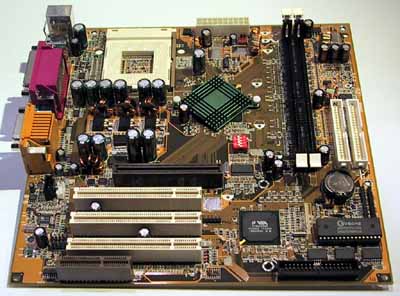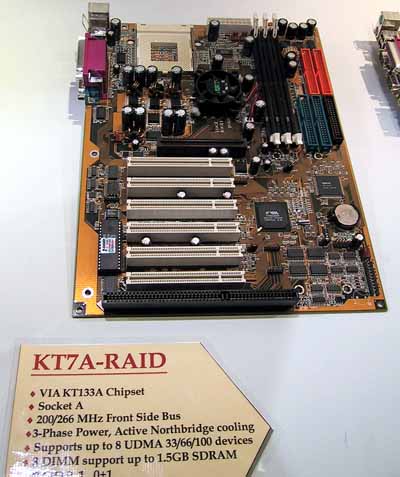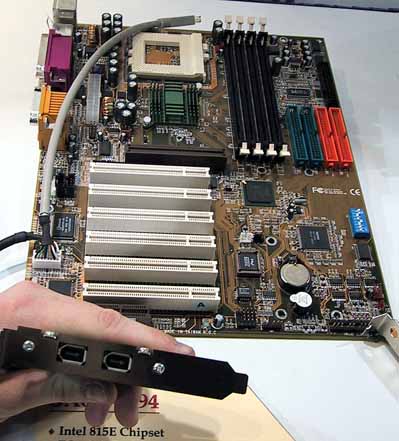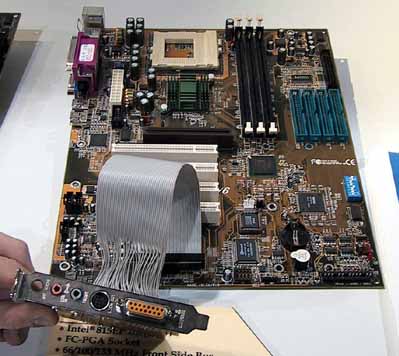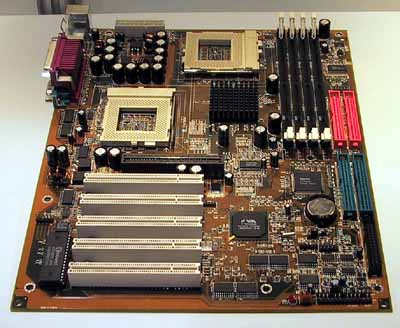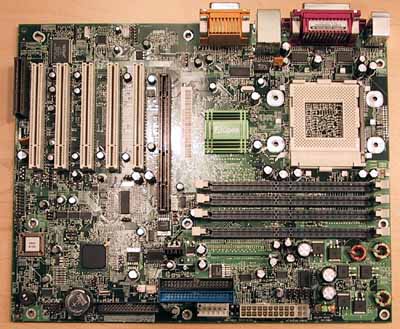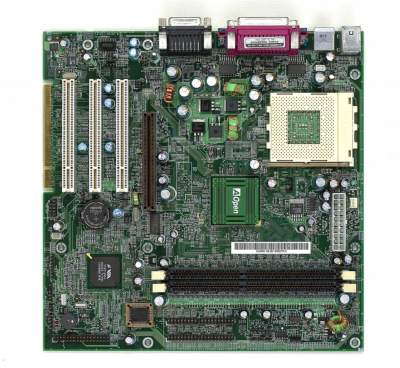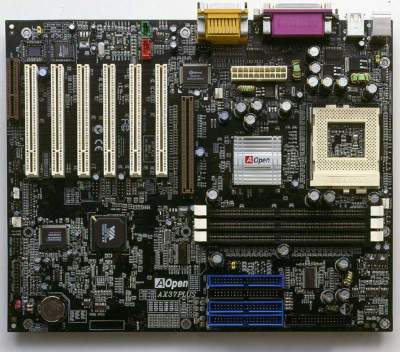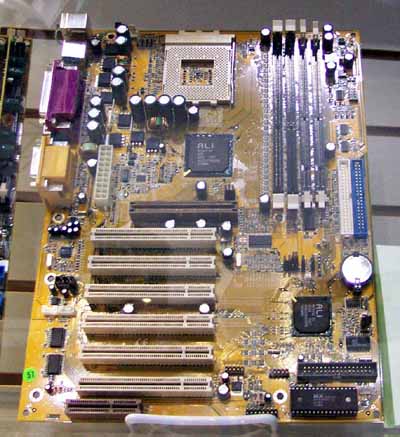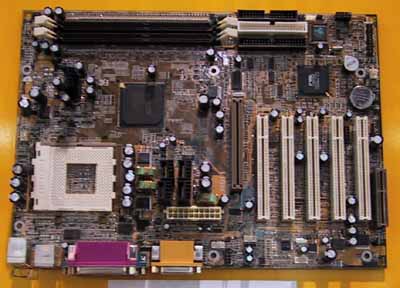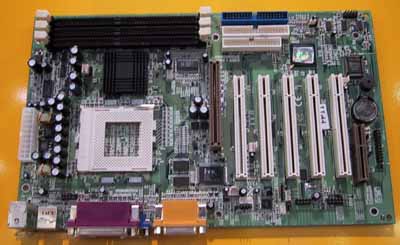
Original Link: https://www.anandtech.com/show/670
Motherboards in 2001 Preview: Part 1
by Henry Kuo on November 27, 2000 1:42 AM EST- Posted in
- Motherboards
Introduction
For years, Comdex in Las Vegas has been a trade show where just about every company in the computer industry demonstrates their new products and presents their new roadmaps. Most of the time it is an indication of what users can expect from those companies over the coming year, at least until the next big trade show, Computex in Taipei, comes along. Over the past two weeks, we’ve already seen AnandTech’s Comdex Fall 2000 Summary, a Video Cards in 2001 Preview, as well as new roadmaps from Intel (including the mobile market) and AMD. Now it’s time to find out what we can expect to see on the motherboard side of things over the next few months.
Of course, the most exciting thing on the horizon is DDR, which was everywhere at Comdex. Most companies demonstrated, or at least showed, their own DDR solutions for AMD or Intel processors. All the big chipset manufacturers, with the notable exception of Intel, released chipsets supporting DDR, including the AMD 760, the VIA Apollo Pro266, the VIA KT266, the ALi Aladdin Pro5, and the ALi MAGiK 1. The AMD 760, VIA KT266, and the ALi MAGiK 1 chipsets support AMD Socket-A processors, while the VIA Pro266 and the ALi Aladdin Pro5 chipsets are designed for Intel Socket-370 processors. Note the lack of DDR support for the Pentium 4, which will probably continue until the 3rd quarter of 2001.
Nevertheless, there was still a lot of hype about motherboards using the Intel i850 chipset, the only chipset for the Pentium 4 for the time being. Quite a few motherboard manufacturers have announced that they will provide i850 solutions, but due to the high price tags for RDRAM and the i850 chipset itself, they did mention that they would monitor the demand and produce the boards accordingly. Not surprisingly, we only saw a few companies actually demonstrating working i850 solutions.
Another trend we saw is a migration towards workstation and server level applications. We saw quite a few boards with integrated IEEE 1394 Firewire, SCSI Controller, IDE RAID, or even dual processor support. Unfortunately, dual Socket-A boards were nowhere to be found and we won’t see them until at least 1st quarter of 2001.
Last of all, the VIA KT133 and Intel i815E are not dead yet by any means. Most of the companies we visited still have solutions using those chipsets, or one of their variants, namely the new VIA KL133, the VIA KM133, the VIA ProSavage PM133, and the Intel i815EP.
Without further ado, let’s get to the motherboard manufacturers and see what new products they’ve got in the pipeline.
ABIT's Socket-A Solutions
ABIT has always been a favorite among hardware enthusiasts, so we know that many of you would love to see what ABIT will offer in the coming months. To our surprise, we did not see a lot of DDR solutions from ABIT yet, although they probably will come in the near future. On the other hand, they really showed their desire to produce boards suitable for high-end server applications. Traditionally, ABIT is not known for having the most stable solutions, making them an unlikely candidate to produce high-end server products. Fortunately, we’ve definitely noticed an upward trend in the quality of ABIT products, so hopefully this new market focus will just continue that evolution process.
This is the KG-20, a micro-ATX board using the AMD 760 chipset. It supports AMD’s Socket-A processors running at 200 or 266 MHz FSB with up to 2GB of DDR SDRAM. Most AnandTech readers would probably be disappointed by this board because it is not a full ATX board, which means it’s expandability is inherently limited. While ABIT claims support for up to 2GB of DDR SDRAM, which is the limit of the 760 chipset, this would require 1GB DIMM’s since there are only 2 DIMM slots, which is not likely to happen any time soon. An ATX version is in the works, so you’ll have to wait a little bit longer if you want a standard ATX DDR solution from ABIT. In fact, this board is the only DDR solution ABIT showed us, but they do plan to have other DDR motherboards using VIA’s DDR chipsets.
Does this board look an awful lot like the KT7-RAID? That’s because it is merely a new version of the board with one important change - the use of the VIA 8363A North Bridge, which enables support for 266MHz FSB AMD processors. With the new North Bridge, the chipset becomes known as the KT133A, hence the addition of the “A” to the model number. The KT7A-RAID looks almost identical with the KT7-RAID, which features support for Socket-A processors, 6 PCI, 1 ISA, and 1 AGP slot, as well as the Highpoint HPT370 ATA 100 RAID controller.
Firewire, 6-channel audio and dual sockets from ABIT
The board above is the SA6R-1394. It is an enhanced version of the ABIT SA6R, which supports Socket-370 Intel processors and features SoftMenu III and the famous Highpoint HPT370 ATA 100 RAID controller. From the name, it is obvious that ABIT has integrated support for IEEE 1394 Firewire. They’ve used a Texas Instruments chipset that is quite common among Firewire solutions, making this motherboard a bit more server-ready. Unfortunately, the i815 is not particularly well suited to a server environment where its 512MB memory limit would be a severe problem. On the flip side, Firewire is becoming increasingly popular for home users as digital video camera with Firewire interfaces gain popularity, so an i815 board with such support is not a bad idea at all.
We were not able to get confirmation, but it seems that this Firewire solution is a single chip one. In the past, Firewire has generally been implemented with a two-chip solution, which takes up more PCB space and increases the cost by a fair amount - something motherboard manufacturers have pointed to as limiting the adoption of integrated Firewire. If ABIT can implement a one-chip solution, that should help to reduce the price of this motherboard. Don’t be surprised to see it show up on more boards as time goes on.
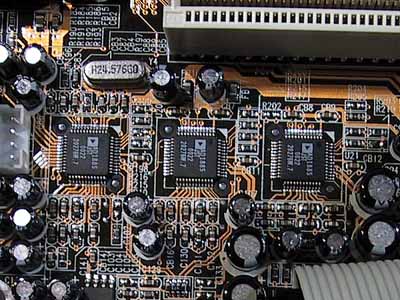
To a great extent, on-board audio has been ignored by most hardware enthusiasts, but simultaneously embraced by OEM’s looking to cut costs. For many end users, these CODEC’s are far from satisfactory, so they end up getting a dedicated PCI sound card. But the ABIT SV6, shown above, uses 3 on-board CODEC’s to provide 6-channel audio. More than likely, this will again be something that OEM’s love and hardware enthusiasts hate. It will be something that OEM’s can advertise on their list of features, while those choosing to use a hardware-based PCI sound card will have to pay for it even if they don’t use it. This Socket-370 motherboard, the SV6, also features the Highpoint HPT370 ATA 100 RAID controller.
The ABIT VP6 is shown above. Think of it as the replacement for the extremely popular BP6, which was the first dual Socket-370 board on the market back when Celeron’s were the only Socket-370 processors. With the VP6, the i440BX is replaced by the VIA Apollo Pro 133A and the Highpoint HPT366 by the HPT370. That means we get official 133MHz FSB, FC-PGA CPU support, AGP 4X, and ATA 100 RAID.
AOpen does the Pentium 4
At the AOpen booth, they were showcasing pretty much what other manufacturers had at their booths, including Pentium 4 and DDR solutions. Let’s start with their Pentium 4 motherboard.
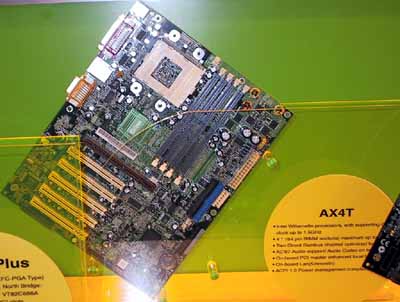
The above pictures are of the AX4T, supporting Pentium 4 processors of up to 1.5GHz, 512MB of RDRAM, and on-board audio and LAN. Notice the four big silver “circles,”two on each side, around the CPU socket. That’s where the Pentium 4’s retention mechanism is mounted.
Besides the Intel Pentium 4 board, AOpen will also release the MK7A, which uses the AMD 761 North Bridge, supporting 200/266 MHz FSB AMD CPU’s and DDR SDRAM. For the South Bridge, they will use the VIA 686A Super South Bridge to reduce costs. The board will come in the micro-ATX form factor, but AOpen will release a standard ATX version of the board a bit later on.
AOpen's VIA Solutions
AOpen will also have the AX37, a VIA Apollo Pro 266 board for Socket-370 processors with DDR SDRAM support. There will also be a micro-ATX version, called the MX37, and a "plus" version, called the AK37Plus. The "plus" model adds a Promise Ultra ATA 100 RAID controller, Die-Hard BIOS support, as well as the other tweaks we've come to see on the enhanced versions of AOpen boards.
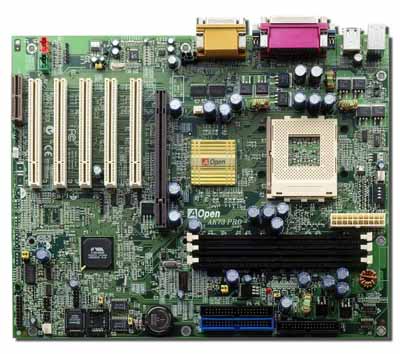
The picture above is the AK73Pro, which is a KT133 motherboard for AMD processors, similar to the AK33 but with more FSB speed settings, a gold-plated heatsink on the North Bridge, and AOpen’s Die-Hard BIOS. It should be hitting streets any time now. Within the next month, AOpen will release another variation of this board, the AK73Pro-1394. As the name suggests, they will be integrating IEEE 1394 Firewire, preparing it for high-end workstation applications.
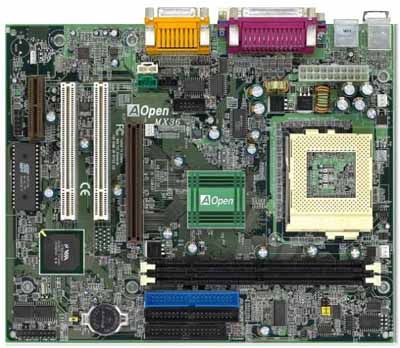
Here we have the MX36, a Socket-370 micro-ATX board using the new VIA ProSavage PM133 chipset. The PM133 chipset is similar to the VIA Apollo Pro 133A, but with integrated S3 Savage 4 video. Note that there is still an external AGP 4X slot for future graphics upgrades, just like on the i815. However, also like the i815, a graphics card in the AGP slot disables the onboard video automatically.
Three Letters for Chaintech: DDR
Chaintech has also focused on the different kinds of DDR solutions. However, only the DDR solution for Socket-370 processors was shown, whereas their DDR solution for AMD processors are not ready yet. They are still deciding which chipset(s) they will use for DDR, and also which model(s) will be shipped to the US. As far as the Intel i850 chipset goes, Chaintech told us that a board using the chipset is coming, but they could not provide us with any further details.
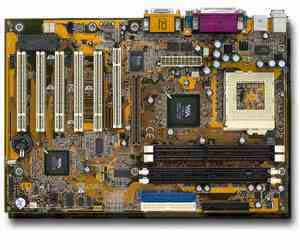
Above, you can see the 6JVD2, Chaintech’s DDR solution for Socket-370 processors. It uses the VIA Apollo Pro266 chipset, including the 8633 North Bridge and the VIA 8233 Super South Bridge combination. The North/South Bridge nomenclature may actually be a bit of a misnomer here now that VIA is using V-Link to connect their upcoming chipsets. V-Link is much like Intel’s Hub Architecture, providing a dedicated link, rather than just the PCI bus, between the two key chipset components.
The 6JVD2 has two DDR DIMM slots and two “normal” SDR DIMM slots, so users can choose to stay with their current PC133 SDRAM if they want to. There is another variation of the board, the 6JVD, which has three DDR slots and no SDR slots.
Notice the “inverted” PCI slot next to the AGP slot. That is called an ACR slot and is VIA’s answer to the Intel CNR slot. It's supposed to provide the same functionality, with room to expand since many of the pins remain unused. By using a backwards PCI slot, there is no additional cost for producing a new connector. Unfortunately, it probably means that you cannot have a shared ACR/PCI slot like you can with CNR/PCI without the use of special “thin” PCI connectors, like we saw on the ASUS CUSL2.
Above is the Chaintech 7RJD2 using the ALi 1647 North Bridge, the core of the MAGiK 1 chipset. It supports 200/266 MHz FSB AMD processors as well as DDR SDRAM. It has two DDR slots and two “normal” SDR slots, so you can choose to stay with your current PC133 SDRAM. Another variation of the board, the 7RJD, has three DDR slots and no SDR slots. The South Bridge here is the ALi 153D+.
Chaintech has two other motherboards providing DDR support for AMD processors - the 7VJD/2 and the 7KJD. The 7VJD/2 uses the VIA KT266 chipset, supporting 200/266 MHz FSB AMD processors. The 7VJD has three DDR DIMM slots, where the 7VJD2 has two DDR slots and two SDRslots. The 7KJD uses the AMD 761 / VIA 8231 combination, and has two DDR slots.
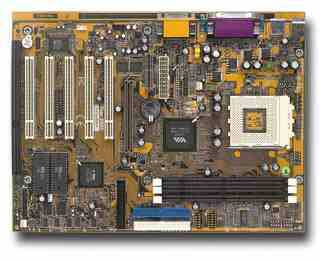
This is the 7AJV2, which is similar to the 7AJA2 (KT133 chipset), but uses the KM133 chipset instead. The KM133 chipset is a drop in (ie pin compatible) replacement for the KT133 that adds integrated S3 Savage 4 video.
EPoX Boasts new Features
We actually missed the EPoX booth during Comdex, but they were nice enough to offer us a visit to their office in Southern California, where we were able to look at a lot of new products. So far EPoX has two DDR solutions, one for AMD and one for Intel processors. They are planning on releasing a board using the Intel i850 chipset as well, but probably with limited availability because of the high price of RDRAM.
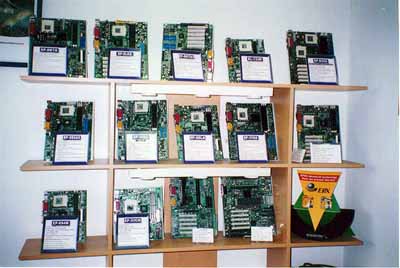
This is a snapshot of their shelf holding most of their newest products.
There are two things that EPoX will start to include with their motherboards. The first is what they call the “Window Overclock.” Similar to the Fuzzy Logic from Microstar, EPoX supplies you with software, called Boostek, so that users can overclock their CPU directly from within Windows.
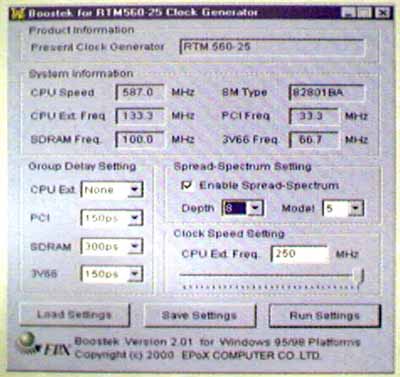
The second thing is the implementation of their “P80P POST” (Power On Self Test) on the motherboard itself. Basically, the P80P is a POST card that reports the different stages during a boot up process, so if something is wrong with the computer and prevents it from boot up, you can use the code shown on the two 8 segment LED’s to look up what could have gone wrong. Again, it is something similar to the D-LED technology from Microstar, but the P80P POST can provide up to 128 states - much more than the 16 states provided by Microstar’s D-LED. However, EPoX will only include this feature in their high-end boards.
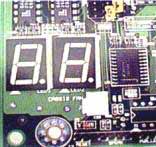
EPoX shows us DDR, KT133A and more
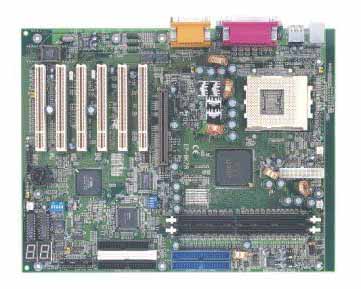
This is the EPoX EP-8K7A which was actually demonstrated during Comdex. The board should be ready to ship by the end of the month. It uses the AMD 761 North Bridge and the VIA 686B South Bridge, supporting 200/266 MHz FSB AMD processors, and up to 2GB of DDR SDRAM. Once again, with only 2 DIMM slots, it’s unlikely that the 2GB memory limit of the AMD 761 North Bridge will actually be attained any time soon by this board.It also has the Highpoint HPT370 ATA 100 RAID and the P80P POST diagnostic tool.

The EP-3VHA, shown above, is EPoX’s Socket-370 DDR solution. It uses the VIA Apollo Pro266 chipset and offers three DIMM slots, supporting up to 1.5GB DDR SDRAM.
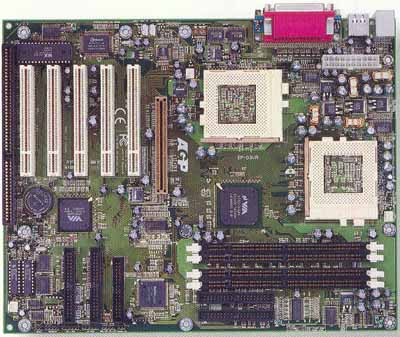
The other board that EPoX demonstrated during Comdex was the EP-D3VA, shown above. It is a dual Socket-370 motherboard using the VIA 694X / 596B combination. Once again, we can see a push from manufacturers towards high-end servers applications. The four DIMM slots support up to 2GB of SDRAM.
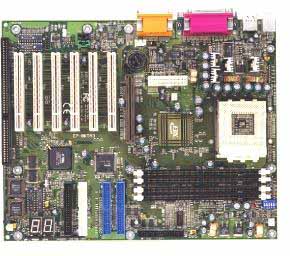
This is the EP-8KTA3. It is similar to the EP-8KTA2, with the exception that EPoX uses the updated North Bridge from the VIA KT133A chipset, so the board supports 200/266 MHz FSB AMD processors.

This is the EP-3SLA, a VIA PM133 board for Intel’s Socket-370 processors. Like the KM133, it features integrated S3 Savage 4 video.
FIC
FIC also showed us their DDR solutions as well as variations of some boards we have already seen. So far they have one DDR solution for AMD processors and one for Intel processors. FIC has not announced a board using the i850 chipset yet, but they told us that one should be ready early next year.
Above is the AD11, FIC’s Socket-A DDR solution. It uses the AMD 761 North Bridge and the VIA 686B South Bridge. It supports 200/266 MHz FSB AMD processors and up to 2GB of DDR SDRAM. Once again, that 2GB limit of the 761 North Bridge is going to be tough to reach with only 2 DIMM slots on the AD11.
This is the FP11, FIC’s DDR solution for Socket-370 processors. It uses the VIA Apollo Pro266 / chipset. The board displayed is not the final version , which should add optional IDE RAID and an ACR slot.
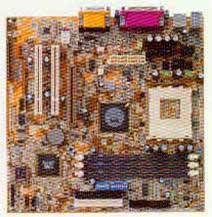
FIC also has the AM33, using the VIA KM133 chipset. The Socket-370 equivalent of the AM33 is the FR31, which uses the VIA PM133. Otherwise the AM33 and FR31 are more or less the same feature-wise, with both boards using the integrated Savage4 video of their respective chipsets from VIA and offering similar expansion options.
Final Words
Click here to read part 2 of our motherboards in 2001 preview.

